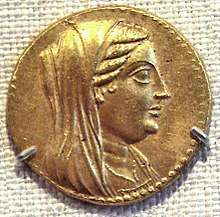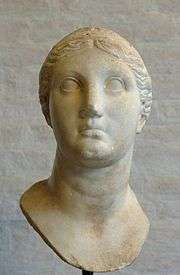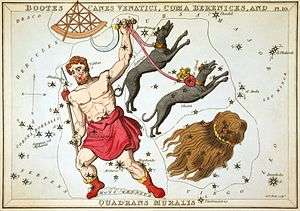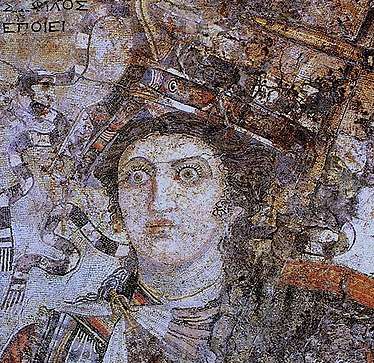Berenice II of Egypt
| Berenice II | |||||||||||||||||||||||||||||||||||||||||||||||||||||||
|---|---|---|---|---|---|---|---|---|---|---|---|---|---|---|---|---|---|---|---|---|---|---|---|---|---|---|---|---|---|---|---|---|---|---|---|---|---|---|---|---|---|---|---|---|---|---|---|---|---|---|---|---|---|---|---|
| Queen of Egypt | |||||||||||||||||||||||||||||||||||||||||||||||||||||||
 | |||||||||||||||||||||||||||||||||||||||||||||||||||||||
| Born | c. 267 – 266 BC | ||||||||||||||||||||||||||||||||||||||||||||||||||||||
| Died | 221 BC | ||||||||||||||||||||||||||||||||||||||||||||||||||||||
| Spouse |
Demetrius the Fair Ptolemy III Euergetes | ||||||||||||||||||||||||||||||||||||||||||||||||||||||
| Issue |
Ptolemy IV Arsinoe III Alexander Magas Berenice | ||||||||||||||||||||||||||||||||||||||||||||||||||||||
| |||||||||||||||||||||||||||||||||||||||||||||||||||||||
| Dynasty | Ptolemaic | ||||||||||||||||||||||||||||||||||||||||||||||||||||||
| Father | Magas of Cyrene | ||||||||||||||||||||||||||||||||||||||||||||||||||||||
| Mother | Apama II | ||||||||||||||||||||||||||||||||||||||||||||||||||||||
Berenice II (267 or 266 BC – 221 BC) was a ruling queen of Cyrene by birth, and a queen and co-regent of Egypt by marriage to her cousin Ptolemy III Euergetes, the third ruler of the Ptolemaic dynasty of Egypt.
Life

She was the daughter of Magas of Cyrene and Queen Apama II. She was the grand-daughter of Berenice I.
Queen of Cyrene
In approximately 249 BC, her father died, making Berenice ruling queen of Cyrene. Soon after her father died, Berenice was married to Demetrius the Fair, a Macedonian prince. Berenice had no children with Demetrius.[1]
After Demetrius came to Cyrene, he became the lover of her mother, Apama. In a dramatic event, Berenice had him killed in Apama's bedroom. Berenice stood at the door and instructed the hired assassins not to hurt her mother while she attempted to protect her mother's lover. Apama lived on afterward. Although there were many plots to assassinate her, all hired assassins became fearful of her "exceptional courage."[2]
Queen of Egypt

After the death of Demetrius, Berenice married Ptolemy III.
Berenice is said to have participated in the Nemean Games (between 245 and 241 BC) and to have competed in Olympic games at some unknown date. Berenice had a strong equestrian background and was accustomed to fighting from horseback. According to Hyginus's Astronomica, he tells of when Berenice's father Magas, king of Cyrene in modern day Libya, and his troops were routed in battle, Berenice mounted a horse, rallied the remaining forces, killed many of the enemy, and drove the rest to retreat.[3]
Soon after her second husband's death in 221 BC, she was murdered at the instigation of her son, Ptolemy IV, with whom she probably was associated in the government.[4]
Nevertheless, a decree “issued delineating the cult for the newly deified queen Berenike II…specified that men and women singers were to sing all day in front of the statue of Berenike.”[5]
Issue
With Ptolemy III she had the following children:[6]
- Arsinoe III, born in c. 246/245 BC. She later married her brother Ptolemy IV
- Ptolemy IV Philopator, born c. 244 BC
- Possibly Lysimachus. The name of the son is not known, but he is said to have been born in c. 243 BC.[7]
- Alexander, born in c. 242 BC [8]
- Magas, born in c. 241 BC. Scalded to death in his bath by Theogos or Theodotus, at the orders of Ptolemy IV.[9]
- Berenice, probably born in c. 239 BC and died a year later.[10]
Myths

During her second husband's absence on an expedition to Syria, she dedicated locks of her hair to Aphrodite for his safe return and victory in the Third Syrian War, and placed the offering in the temple of the goddess at Zephyrium. By some unknown means, the hair offering disappeared when Ptolemy returned to Egypt, Conon of Samos explained the phenomenon in courtly phrase, by saying that it had been carried to the heavens and placed among the stars. The name Coma Berenices or Berenice's hair, applied to a constellation, commemorates this incident. This made the locks of Berenice the only war trophy in Greco-Roman sky.[2] Callimachus celebrated the transformation in a poem, of which only a few lines remain, but there is a fine translation of them by Catullus.[4] Neoclassical painters illustrated this theme abundantly.
The city of Euesperides was refounded by her and received her name, Berenice (near the location of Benghazi). The asteroid 653 Berenike, discovered in 1907, also is named after Queen Berenice.[13]
References
- ↑ Berenice II Archived February 25, 2015, at the Wayback Machine. by Chris Bennett
- 1 2 Pennington, Reina (2003). Amazons to Fighter Pilots: A Biographical Dictionary of Military Women. Westport, CT: Greenwood Press. p. 54. ISBN 0313327076.
- ↑ Pennington, Reina (2003). Amazons to Fighter Pilots: A Biographical Dictionary of Military Women. Westport, CT: Greenwood Press. p. 53. ISBN 0313327076.
- 1 2

- ↑ See Elisabeth Meier Tetlow, Women, crime, and punishment in ancient law and society, Volume 2 (New York: Continuum International Publishing Group, 2005), 212.
- ↑ Dodson, Aidan and Hilton, Dyan. The Complete Royal Families of Ancient Egypt. Thames & Hudson. 2004. ISBN 0-500-05128-3
- ↑ Lysimachus by Chris Bennett
- ↑ ALexander by Chriss Bennett
- ↑ Magas by Chris Bennett
- ↑ Berenice by Chris Bennett
- ↑ Fletcher, Joann (2008). Cleopatra the Great: The Woman Behind the Legend. New York: Harper. ISBN 978-0-06-058558-7, image plates and captions between pp. 246-247.
- ↑ Pfrommer, Michael; Towne-Markus, Elana (2001). Greek Gold from Hellenistic Egypt. Los Angeles: Getty Publications (J. Paul Getty Trust). ISBN 0-89236-633-8, pp. 22–23.
- ↑ Use of tree Oils. "Varnish and Berenice." Retrieved on September 02, 2010
External links
| Wikimedia Commons has media related to Berenice II. |


